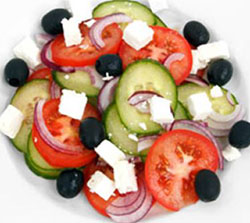Could Your Family Benefit from Following the Mediterranean Diet?
Sheila Gains, Family and Consumer Science Agent, Colorado State University Extension, Arapahoe County

Studies show that for most people, following the Mediterranean Diet can reduce their risk for many diseases such as cancer, heart disease, diabetes, and Alzheimer’s disease. The entire family can benefit from following the Mediterranean lifestyle, which includes the healthy foods listed below, 30 minutes of daily physical activity and taking time to relax and enjoy meals and activities with family and friends.
Following the Mediterranean lifestyle is not an “all-or-nothing” deal. You do not need to follow the diet and lifestyle completely every day of the week to improve your health. Find some easy changes to make for your family, and try to stick with them most of the time, then decide on a few more and slowly work them into your family’s lifestyle.
What foods are included in the Mediterranean diet?
- Whole grains. Whole grains provide more fiber, B vitamins, magnesium, iron and selenium than processed grains.
- Fruits and Vegetables. A wide variety, often eaten seasonally and locally grown. These are low-calorie, nutrient dense, high fiber foods that have lots of antioxidants and protective phytochemicals.
- Legumes (dried beans and peanuts), nuts and seeds. These are a great source of plant based protein and healthy fats.
- Olive oil. This is the main source of fat in the Mediterranean diet. Olive oil is high in monounsaturated fat which may protect you from heart disease and stroke. It is also high in compounds that can reduce inflation. It can replace butter, lard and hydrogenated oils in most recipes.
- Seafood, poultry and eggs are eaten more often than other meats.
- Low fat dairy, mostly as yogurt and cheese provides high quality protein, calcium and if fortified, Vitamin D for strong bones.
- Fresh herbs and spices are added for flavor and can replace the need for added salt.
- Red wine, for adults only. Red wine contains alcohol and a compound called resveratrol that may help prevent damage to blood vessels and reduce LDL cholesterol and prevent blood clots. Red wine can be consumed moderately (one 5 oz. glass) and with a meal.
Sample One-day Menu:
| Breakfast | 1 cup cooked oatmeal Top with: ½ sliced banana, ½ cup low-fat plain yogurt, drizzle with 1 Tbsp. olive oil and 1 tsp. honey Snack ½ cup carrot sticks |
| Snack | ½ cup carrot sticks |
| Lunch | 2 cups mixed greens with: 2 oz. broiled salmon, (or 2.5 oz. pouch or can of tuna or salmon), ½ cup grape tomatoes, ¼ cup sliced red onion, and 1 oz. feta cheese, tossed with 1 Tbsp. olive oil and some balsamic vinegar½ whole-wheat pita bread with ¼ cup hummus Small apple |
| Snack | 1 oz. pistachios |
| Dinner | Pasta primavera with: 1 cup whole wheat penne pasta, 2 cups roasted vegetables, and 2 ounces diced chicken breast, tossed with 1 Tbsp. olive oil, crushed garlic, herbs, and lemon juice3/4 cup berries over ½ cup low-fat plain yogurt http://www.liveeatplay.colostate.edu Mediterranean Diet, Nov 2013 |
In the above example children could pack a tuna or nut butter sandwich made on whole grain bread or in a whole grain pita pocket. Include vegetables like carrot, celery, cucumber slices to dip into a small container of hummus and a piece of fruit.
Many of the foods in the Mediterranean diet are widely accepted by children. If they object to whole grain products, try white whole wheat products (bread, pasta, etc.) or make food with half whole grains such as half brown rice and half white rice mixed together after cooked separately (Brown rice take longer to cook than white rice.). Some children object to fish, “tastes too fishy”, so experiment with mild flavored fish like tilapia, cod, or orange roughy. Try serving cooked fish, chopped and lightly flavored with taco seasoning. Serve seasoned fish in a taco shell with all the traditional toppings such as salsa and shredded lettuce.
Let’s Talk:
Children are more likely to try and accept new foods if they are part of the process of picking out and/or making new foods. Ask children to help you pretend you are traveling to a Mediterranean country to taste healthy foods children eat in that country (Greece, Southern Italy or Spain).

Recipe for Health:
Homemade Hummus
1 (15 ounce) can garbanzo beans, drained
1 tablespoon lemon juice
2 tablespoons olive oil
1 clove garlic, crushed
½ teaspoon cumin
½ teaspoon salt
1 tablespoon tahini (sesame seed paste) or peanut butter
Water, as needed (up to ¼ cup)
Directions:
Blend all ingredients in a food processor. Stream water if needed into mixture as it blends, making a thick dip. Serve with whole grain pita chips or fresh vegetables.





